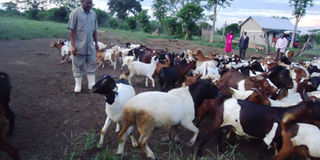The market opportunities for goat farmers

A farmer shows off his goat farm to visitors. FILE PHOTO
What you need to know:
The sector has attracted vast investments of over $176m (Shs 449.6b) from both local and foreign investors
As part of the series leading to the Farm Clinic this Saturday, June 14, which will focus on goat farming, This article covers the place of goats in the livestock sector.
The livestock sector is one of Uganda’s important growth sectors; It constitutes 17 per cent of the agricultural gross domestic product (GDP) and is a source of livelihood to about 4.5 million people.
The sector is categorised into cattle, goats, pigs, sheep and poultry. The growing local and regional demand for meat and milk products has increased the number of livestock in the country over the years.
The numbers
The 2008 national livestock census estimated the number of goats at 3.4 million. In economic value, though cattle are considered the most important livestock, others such as goats, sheep, pigs and poultry are equally important; 98.7 per cent of goats in Uganda are indigenous whereas 1.3 per cent are exotic (Boer 79.1 per cent and Galla 3.7 per cent).
The annual production of livestock products has recorded progressive growth since 2004. Uganda’s meat processing firms produce between 300 and 700 kgs of meat products daily.
The national per capita consumption ofmeat is estimated at 6 kgs while the annual meat consumption deficit is estimated at 80,000 metric tonnes.
Opportunities for large scale meat production and processing exist to step up the current production levels which only meet half of the national demand.
The hides, skins and furskins are the major export earners followed by dairy products and bird eggs, meat, live animals and meat preparations. The major export markets are Kenya, Tanzania, Rwanda, Southern Sudan, D R Congo and Burundi. Southern Sudan is the major destination for Uganda’s meat products. Other potential export markets in the Middle East and the European Union.
Competitive strengths
• Ugandan beef industry is compliant with the Arabic norms of Halaal in the animal slaughtering process;
• Tropical weather climate favours Livestock farming;
• Adequate supply of trained & affordable human resources such as Veterinary doctors, agriculturalists, farm engineers and researchers.
• Available market for livestock and its products in Uganda, within the EAC and the COMESA region comprising over 495 million people.
• Research & Development is ably supported by the National Agricultural Research Organisation (Naro) and the National Agriculture Advisory service (Naads). Through research, technologies in the sector have been generated to improve productivity in animal health, pasture feed production, breeding and nutrition of livestock.
• Uganda has about 1,000 valley dams and tanks to supply water to livestock.
• Current legal framework supports private sector investment.
Investment in the sector
70.8 per cent of Uganda’s households are engaged in livestock rearing and 99.1% engage their families as the main source of labour for livestock rearing (National Livestock Census 2008).
The sector has attracted vast investments of over $176m (Shs 449.6b) from both local and foreign investors. The investments include ranching, meat processing, breeding/farming and leather processing. The sector has also created employment opportunities for farmers, butchers veterinary doctors, farm engineers and researchers among others.
Source: Uganda Investment Authority




